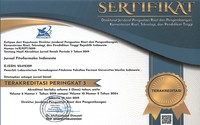Potency of Cinnamomum burmannii as Antioxidant and α Glucosidase Inhibitor and Their Relation to Trans-Cinamaldehyde and Coumarin Contents
Abstract
Keywords
Full Text:
PDFReferences
Blahova, J., and Svobodova, Z., 2012, Assessment of Kumarin level in ground Cinnamon available in the Czech retal market, The Scientific Worl Journal, vol 2012.
Paranagama,P.A., Wimalasena,S., Jayatilake,G.S., Jayawardena,A.L., Senanayake,U.M., and Mubarak,A.M., 2001, A comparison of essential oil constituents of bark, leaf, root, and fruit of Cinnamon (Cinnamomum zeylanicum Blum) grown in Sri Lanka, Journal natn.Sci. Foundation Sri Lanka 29 (3 & 4): 147 – 153.
Chen,P., Sun, J., and Ford,P., 2014, Differentiatio of the four major species of Cinnamons (C. burmannii, C. verum, C. cassia and C. loureiroi) using a flow injection mass spectrometric (FIMS) fingerprinting method, Journal Agric. Food. Chemistry, 62 (12): 2516-2521.
Ferry, Y., 2013, Prospek Pengembangan Kayu Manis (Cinnamomum burmannii L) di Indonesia, Sirinov, vol.1, no.1,pp 11-20.
Wang,Y-H., Avula,B., Nanayakhara,N.P., Zhao, J., and Khan, I.A., 2013, Cassia cinnamon as asource of coumarin in cinnamon-flavored food and food supplements in the United States, Journal of Agricultural and Food Chemistry, 61(18):4470-4476.
Scientific Opinion of the Panel on Food Additives, Flavourings, Processing Aids and materials in contact with Food on a request from the European Commision on Kumarin in flavourings and other food ingredients with flavouring properties. The EFSA Journal (2008) 793, 1-15.
Nabavi,S.F., A.D. Lorenzo, M. Izadi, E. Sobarzo-Sanchez, M. Daglia, and S.M. Nabavi, 2015, Antibacterial effects of Cinnamon: From farm to food, cosmetic and pharmaceutical industries, Nutrients, Vol. 7: 7729- 7748.
Singleton, V.I., Rossi, Jr. J.A., 1965, Colorimetry of total phenolics with phosphomolyddic phosphotungistic acid reagents. American Journal of Enology and Viticulture, 16:144-158.
Yen,G.C., Duh,P.D.,1994, Scavenging effect of methanolic extract of peanut hulls on free radical and active-oxygen species, Journal Agric.Food. Chem., 42:629-632.
Saijyo, J.,Suzuki, Y., Okuno, Y., Yamaki, H., Suzuki, T., and Miyazawa, M. 2008. α-Glucosidase Inhibitor from Bergernia ligulata. J. Oleo Sci. 57, (8) 431-435
Wardatun,S., Rustiani, E., Alfiani, N., Rissani, D., 2017, Study effect type of extraction method and type of solvent to Cinnamaldehyde and Trans Cinnamic acid dry extract Cinnamon (Cinnamomum burmannii (Ness & T.Ness) Blume. Journal Young Pharm. 9(1) Suppl: 49-51.
Yang, C-H., Li, R-X and Chuang, L-Y, 2012, Antioxidant activity of various parts of Cinnamomum cassia extracted with different extraction methods, Molecules, 17:7294-7304.
Jayatilaka, A., Poole,S.K., Poole, C.F., and Chichila, T.M.P., 1995, Simultaneous micro steam distillation/solvent extraction for the isolation of semivolatile flavour compounds from cinnamon and their separation by series coupled-column gas chromatography, Analytica Chemica Acta, vol. 302, no.2-3,pp. 147-162.
Devi SL, Kannappan S, Anuradha CV., 2007, Evaluation of in vitro antioxidant activity of Indian bay leaf, Cinnamomum tamala (Buch. – Ham.) T. Nees & Eberm using rat brain synaptosomes as model system. Indian J of Exp Biol.;45:778-84.
Chacraborty, Usha., Das, Hariswami., 2010, Antidiabetic and antioxidant activities of Cinnamomum tamala leaf extracts in STZ-treated diabetic rats. Global J of Biotech & Biochem.;5(1):12-18.
Palanisamy,P., K.R. Srinath, D.Y. Kumar, & P. Chowdary C., 2011, Evaluation of Anti-oxidants and Anti-diabetic Activities of Cinnamomum tamala Linn Leaves in Streptozotocin-induced Diabetic Rats, International Research Journal of Pharmacy, 2 (12): 157-162.
Ziegenfuss, T.N., J.E.Hofheins & R.W. Mendel, 2006, Effects of a Water-Soluble Cinnamon Extract on Body Composition and Features of the Metabolic Syndrome in Pre-Diabetic Men and Women, Journal of the International Society of Sports Nutrition 3(2): 45-53.
Kim SH, Hyun SH, Choung SY., 2006, Anti-diabetic effect of cinnamon extract on blood glucose in db/db mice. J Ethnopharmacol.;104(1-2):119-23.
Rekha N, Balaji R, Deecaraman M., 2010, Antihyperglycemic effects of extracts of the pulp of Syzygium cumini and bark of Cinnamomum zeylanicum in streptozotocin-induced diabetic rats. J Appl Biosci.;28:1718-1730.
Hassan, S.A., R. Barthwal, M.S. Nair, & S.S. Haque, 2012, Aqueous bark Extract of Cinnamomum zeylanicum: A Potential Therapeutic Agent for Streptozotocin-induced Type 1 Diabetes Mellitus (T1DM) Rats, Tropical Journal of Pharmaceutical Research 11 (3): 429-435.
Sarjono, Purbowatiningrum Ria., Ngadiwiyana, Ismiyarta, Nor Basyid A. Prasetya. 2010. Aktivitas Bubuk Kayu Manis (Cinnamomum cassia) sebagai Inhibitor Alfa-Glukosidase. Jurnal Sains & Matematika (JSM) Volume 18 Issue 2.
Gunawan, Cristha Octaviani dan Andrian Suhendra. 2013. Efek Kayu Manis (Cinnamomum burmannii) Terhadap Kadar Glukosa Darah Postprandial. http://repository.maranatha.edu/12183/10/1010066_Journal.pdf
Hananti, Rina Sari., Saeful Hidayat, Lisma Yanti. 2012. Uji Aktivitas Antidiabetes Ekstrak Etanol Kulit Kayu Manis (Cinnamomum burmanii Nees ex.Bl.) Dibandingkan Dengan Glibenklamis Pada Mencit Jantan Galur Swiss Webster Dengan Metode Toeransi Glukosa. Indonesian Journal of Pharmaceutical Science and Technology (JSTFI) Vol.I, No.1
DOI: https://doi.org/10.33096/jffi.v7i3.639
Copyright (c) 2020 Jurnal Fitofarmaka Indonesia

This work is licensed under a Creative Commons Attribution-ShareAlike 4.0 International License.
Indexed by:
ISSN: 2356-0398 | e-ISSN: 2541-2329
Editor's Address:
Third Floor Pharmacognosy-phytochemistry laboratory building, Urip Sumoharjo road km. 5 Campus II UMI, Makassar, South Sulawesi, Indonesia
Phone: +6281524045514
Fax: +62411425619
E-mail: editorjfi@umi.ac.id

















.jpg)

